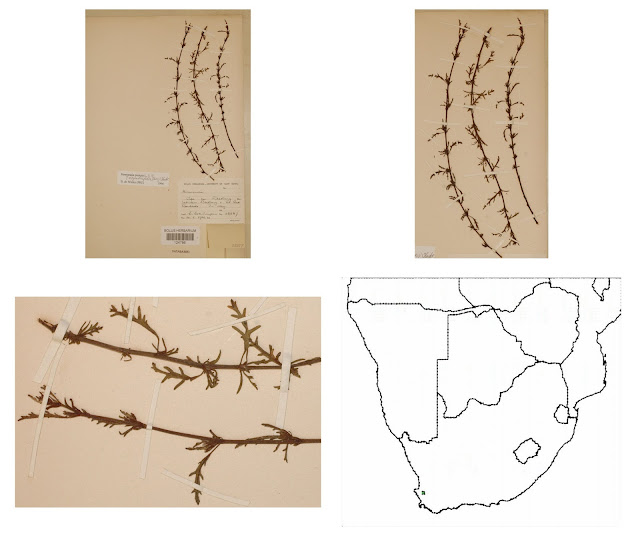The Plant Collective #5 outing to Piketberg yielded a few gems with various strategies to promote outcrossing - transferring pollen between plants rather than within a plant. All these plants were found along the road reserve - in dire peril of being trashed. The vast majority of the road reserve had been mowed or herbicided, and thus was a combination of weeds and grass. Our target for the trip was
Hermannia mysteriosa m.s.. It was first collected by Elsie Esterhuysen without flowers in 1956, and thus never described. I accidentally chanced upon it twelve years ago, also a sterile specimen, and vowed to return to collect it one day. Twelve years later I returned, but the area I collected it in was unrecognisable. The vegetation has been transformed into wheatfields, and the entire stretch of road that used to house the most delightful assembly of plants had been "maintained" to the detriment of
H. mysteriosa. Is it lost to science forever?
 |
| Hermannia mysteriosa from between Piketberg and Het Kruis - another casualty of road maintenance |
 |
| Serruria |
Our first entrant in the Mr. &Mrs Road Reserve beauty pageant is
Serruria.
Serruria (Proteaceae) is a bisexual genus of 65 species endemic to the Cape Floristic Region (CFR). As with many Proteaceae, the pollen is held on the inside of the petals at the top of the flower tube. The stigma is unreceptive at first, and merely presents the pollen that it gathers from the stamens, hence being called a pollen presenter in the Proteaceae. After a few days, it becomes receptive, and ready to receive pollen from other plants. I stand open to correction, but I would say this is a form of dichogamous outcrossing known as protandry.
 |
| Hemimeris racemosa |
 |
| Hemimeris racemosa - front view |
 |
| Hemimeris racemosa - rear view |
Hemimeris racemosa (Scrophulariaceae) is the next endemic to the CFR, this time with only four recognised species, although I'm convinced that close scrutiny will reveal more species. Despite being bisexual, with a big bulging father christmas beard and a firemans hat, it has got to be Mr. Roadside Reserve. It has the intriguing and unusual feature of being didynamous (male and female seperate), with a peculiar strategy coined by Anton Pauw (2005) as inversostyly (
http://www.ncbi.nlm.nih.gov/pubmed/21646105). To ensure outcrossing, each plant will either have the style in the upright position, or the down side, with the stamen countering it. This means that when a bee collects the nectar, it gets a dab of pollen on its head, and if that is the case, that pollen will only be transferred to a plant with the style in that position. I presume the lower position would dab the pollen under its abdomen.
Even more intriguing is that Anton Pauw (2005), that living legend of nature photography and pollination ecology found that
Rediviva bees visit these flowers. Whereas most bees gather pollen or honey,
Rediviva bees are solitary bees (they don't live in a hive) that are known for their ability to harvest oils. They have legs with brush-like hairs that mop up nectar - in this case from the pits visible from the back. This energy-rich substance they feed to the young developing bees. Incidentally, Kim Steiner discovered 13 new species of
Rediva bee by examining the pollinator of the closely related genus
Diascia. Diascia is distinguished from
Hemimeris by being pink not yellow, and having spurs not sacs. It appears that each species of
Diascia has its own spur length, and thus its own pollinator. Kim coincidentally also discovered 13 new species of
Diascia. Take a look at the amazing pictures on his webpage of bee leg hairs and bee leg-lengths (
http://www.calacademy.org/science_now/archive/academy_research/kim_steiner.php).
 |
| Two plants of Cytinus sanguineus. Most of the plant is underground |
 |
| The exposed male bits (left) and female bits (right). |
 |
| A ring of anthers on the male plant |
 |
| The two glorious lobes. Zoom in for a close look at the glandular hairs. |
 |
| The male with enormous nectar wells below. |
Aah, the heterosexuals make a grandiose entrance in the form of
Cytinus sanguineus (Cytinaceae). On the left we have Mr. Road Reserve with a ring of white anthers, and on the right, his Mrs with giant stigmatic lobes. This species is dioecious from the greek meaning seperate households - the sexes are completely separate. Look closely at the close-up of the female plant and you will notice the wetness. This is nectar that I couldn't resist sticking my tongue into. It was copious and delightfully sweet, the perfect reward for a foraging rodent, and a delight for a team of enthusiasts. Thanks Marion, Boet and Dee.










No comments:
Post a Comment